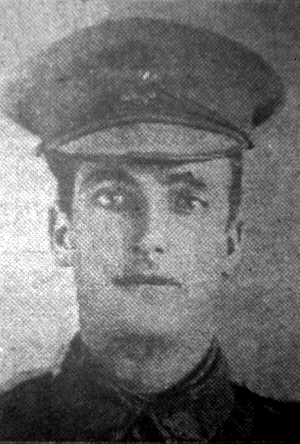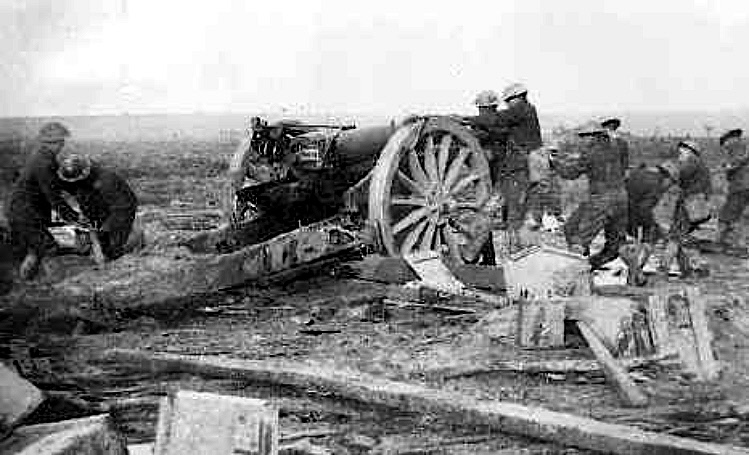
22316, Australian Field Artillery, 7th Brigade, 27th Battery
Frank Terry was born in Gawthorpe, Ossett in Summer 1889, the only son of Miles Terry and his wife, Bell (nee Ramsbottom), who married in early 1873. They had two children: Eva Terry, born 1880, and Frank Terry. In 1891, Miles, a woollen spinner, his wife Bell and their two children were living on Gawthorpe High Street close to Pepper Alley.
When Bell Terry died in 1893, Miles married widow, Mary Furness, at Ossett Holy Trinity Church in June 1900 and by 1901 Miles was working on his own account as a woollen and flock dealer, living with his new wife, and his two children on Dewsbury Road, Ossett. Frank was aged seven and still a scholar at the United Methodist School in Gawthorpe, Ossett.
In 1908 Frank’s sister, Eva, married railway clerk, James Culpan Crossley and they moved to live in Bradford, where they had a son, Arthur, in 1910. They had at least three more children including Frank Crossley, born in Summer 1917, named after Eva’s brother.
In 1911 the Terry family had moved again and Frank, now aged 21, was living at 36, Pickersgill Street, Ossett with Miles and Mary. Frank was working then as an electric engine tenter. Frank’s father, Miles Terry died in early 1926, aged 76.
On the 2nd February 1912, Frank Terry, a gas fitter, travelling alone, sailed from London for Melbourne, Australia aboard the Orient Line ship, ‘Otranto’. He settled in the rural town of Swan Reach, Gippsland, Victoria, about 190 miles east of Melbourne where he worked as a labourer.
Following the outbreak of War between Great Britain and Germany, the Australian Government pledged their support for Britain’s war effort. Frank Terry enlisted in the Australian Imperial Force on the 14th January 1916 and joined 23 Howitzer Brigade, 29th Battery. He embarked for France from Melbourne with his unit on the 20th May 1916, aboard the troopship HMAT ‘Medic A7’. His pay before and after embarkation was 6/- per day.
Frank Terry, aged 29 years, a driver with the 7th Brigade, 27th Australian Field Artillery Battery and service number 22316 was killed in action at Le Cateau on the 22nd October 1918. Frank Terry was posthumously awarded the British and Victory medals, but because he did not serve overseas before the 31st December 1915, he did not qualify for the 1914/15 Star.
The “War Diary” for the 7th Australian Field Artillery Brigade tells us that on the 22nd October 1918, the unit was located at a place called Bandival Farm, south of Le Cateau in northern France and that: “About 5 a.m. the enemy put down a strong Counter Preparation in expectation of our attack, searching well back among the battery areas. Batteries remained silent during the day and proceeded with the carting of ammunition, which was completed by 8 p.m.” Driver Frank Terry and Bombardier Vere Neville Baylis were both killed by the German shelling.
The 7th Field Artillery Brigade, 3rd Division, AIF was formed at the “Warren” a one time convent, in the suburb of Marrickville, New South Wales on 17th March 1916, under the command of Lieutenant Colonel R. St. J. Pearce, VD. The Brigade comprised Brigade Headquarters, 25, 26, 27 and 28 Field Batteries (each of four 18 pounder guns) and 7th Field Brigade Ammunition Column.
The Brigade embarked at Sydney on HMAT ‘Argyllshire’ on the 11th May 1916. It arrived at Portsmouth, England on the 11th July. Training took place at Larkhill, Salisbury Plains, Wiltshire where the 23rd Howitzer Brigade was abolished and 107 Howitzer Battery of this Brigade, with 4.5 inch howitzers, was allocated to 7th Field Artillery Brigade. 28th Field Battery was allocated to a new artillery brigade, the 23rd Field Artillery Brigade.
The brigade disembarked at Le Havre, France on the 31st December 1916. At Stazeele in January 1917, a further re-organisation of the Brigade occurred. The batteries were reformed and made into six gun batteries. The original 27th Battery was cut up and its personnel allocated amongst the other batteries. A new 27th Battery was formed out of the now disbanded 23rd Field Artillery Brigade. This re-organisation was to economise on battery commanders, who were in short supply.
The Brigade went into action on the 17th January 1917 at Armentieres and took part in the battles of Menin Road, Broodseinde, Passchendaele, Morlancourt, Mont St. Quentin, Messines and the Hindenburg Line. Towards the end of the war, in 1918, the Brigade served with the 27th United States Division. On the 3rd April 1919 the 7th and 8th Field Artillery Brigades were amalgamated. By the end of April only about 250 men remained in both brigades and on the 1st May 1919 2nd Division Artillery and 7th Field Artillery Brigade ceased to function. The remaining personnel were formed into one battery (26 Field Battery) and attached to 4th Field Artillery Brigade for demobilisation. On the 18th August 1919, the Brigade was removed from the line of battle

Driver Frank Terry, aged 29 years, son of Miles and Bell Terry, of 34, Pickersgill Street, Gawthorpe, Ossett, died on the 22nd October 1918. He is buried at grave reference at St. Benin Communal Cemetery,2 Nord, France. St. Benin was captured by the 25th Division on the 10th October, 1918.
There are now ten 1914-18 war casualties commemorated in this site. All fell in October, 1918.
References:
1. 7th Australian Field Artillery Brigade War Diary